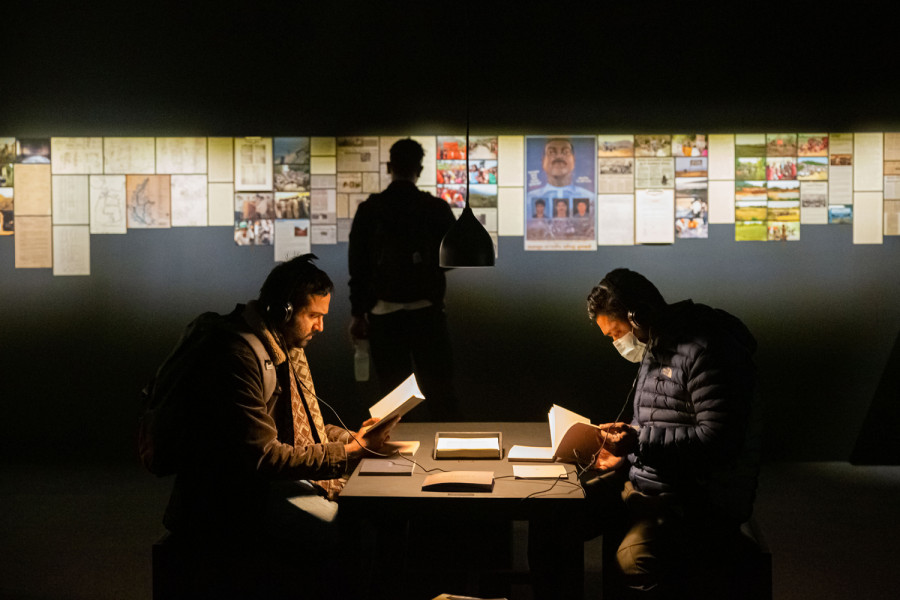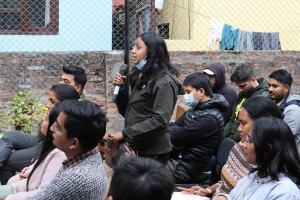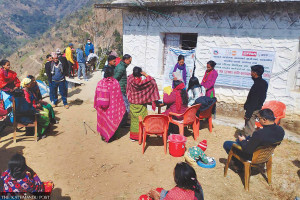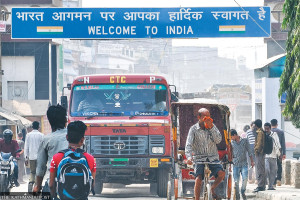 16.12°C Kathmandu
16.12°C KathmanduCulture & Lifestyle
An ode to Odisha’s resilience
Amar Kanwar’s exhibition, ‘The Sovereign Forest’, at Nepal Art Council, exposes governmental injustices against indigenous communities through multimedia displays, powerful narratives and tangible evidence.
Manushree Mahat
The evidence room at Nepal Art Council’s (NAC) ‘The Sovereign Forest’ exhibition displays documentation of a crime against the indigenous community of Odisha. The serene glow of the yellow lamps light up the otherwise dark room, putting the walls adorned by photos, newspaper clippings, legal documents and personal stories at the centre of the exhibition. These are the evidence collected by Amar Kanwar, against the forcible displacement of tribal and indigenous communities of Odisha. Kanwar’s exhibition is a homage to the crime committed against the locals of Odisha, and his way of portraying the struggles of a community that is the victim of what Kanwar describes as ‘a war by the state against its own land and people’.
Darkness shrouds every inch of the room in a deliberate attempt to shine the spotlight on the projection ahead. A quiet film is playing on screen—the kind of quiet that permeates the room to look more closely, to feel the doom of the reality showing on the screen. The film, titled ‘The Scene of a Crime’, depicts the natural environment of Odisha—the forests, the barren lands and the animals, amid the collapse of their habitat, as a story unfolds in the subtitles.
In the adjoining room is a library of sorts, similarly draped in darkness with just enough warm light to give you a sense of quiescent solitude. The curation of this exhibition gives life to Kanwar’s vision; he intended these collections to serve as evidence of the government’s wrongdoing. The careful design of his hard work is emphasised by the creative and thoughtful curation that encourages its viewers to read the displayed books, examine the seeds placed under the warm lights, and seek answers and justice in the walls painted by the stories of the people of Odisha.
The big books in the room are accompanied by a projection that depicts stills filmed by Kanwar—helping the readers visualise the stories of the land he writes about.
The stories on their part are quite unique. One titled, ‘The Counting Sisters and Other Stories’, has fictional tales about the land and people Kanwar met. He breathes life into these stories through simple yet thought-provoking storytelling.
There are also books about protests, recording the efforts of the locals of Odisha in their fight against the government. Kanwar’s work sheds light on those who risked everything in their struggle for their rights. In ‘The Lying Down Protest’, for instance, we see how women and children took a stand against injustice.
Moving on to the next room, a unique yet impactful collection reinforces the exhibition’s message. The space is filled with a collection of rice seeds, collected by a local farmer who, witnessing the destruction of his land, sought to preserve and regenerate seeds that may never bloom due to land acquisition, which has destroyed its habitat.

Kanwar’s emphasis on highlighting the efforts of these persevering locals by bringing the very materials—the very lives—that will be destroyed by rampant ruthless industrialisation forces you to look at the victims of this crime with empathy. It’s difficult to look the other way when the evidence stands right before you at a tangible distance.
The second floor of NAC houses another film projection, titled ‘A Love Story’, an interesting and romantic choice given the tragedy of land grab and the sovereignty questioned by the exhibition. NayanTara Gurung Kakshapati of photo.circle, the presenter of ‘The Sovereign Forest’ in Kathmandu, astutely speculated the reasons behind Kanwar’s decision to name it so. Love, she suggested, lends you the lens of compassion to internalise loss in a different, potent way—there is care and understanding there. “Kanwar has this poetic way of inviting the audience into his work. As artists, it is important and commendable to pull in the viewers to understand the potency of their works,” said Kakshapati during a guided tour of the exhibition.
Loosely called ‘The Evidence Room’, the next room of the exhibition is an amalgamation of the evidence brought by the locals of Odisha to showcase the government’s crimes against them. As described by photo.circle, some of this evidence—in photographs—depicts the systematic destruction perpetuated by the government through the destruction of schools and postal services, to drive the people out of their houses and villages.
This evidence becomes increasingly heavy and difficult to look at. By involving the people affected by the land acquisition, Kanwar’s exhibition drives the emotional palpability of the reality endured by the people. In the evidence room are drawings created by children, featuring scribbles depicting their houses, maps and villages.
There are also inspiring, and encouraging stories of success in this collection. A book titled, ‘The Referendum’, details the legal battle won by a tribal group of Niyamgiri Hills against Vedanta Resources, who wanted to use the forest for mining.
From stories of farmers who lost their lives in their fight against the government, to a diary chronicling the experience of resistance, Kanwar’s works highlight the struggles of people by gathering and preserving their experiences, all while maintaining respect and faithfulness to them.
‘The Sovereign Forest’ is a must-visit exhibition for not only art enthusiasts but for everybody. Kanwar’s work stands as an example of the power of multimedia and art in depicting the harsh realities of the world—demonstrating that creativity is a significant tool in bringing people’s stories to the forefront. Kanwar’s exhibition prompts you to look, read, watch, research and internalise, which is an achievement in itself.
“The exhibition has become a shrine and an archive,” says Kakshapati.








.jpg&w=200&height=120)












